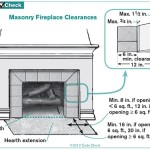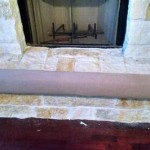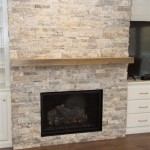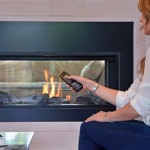How To Paint Fireplace Brick Black: A Comprehensive Guide
Painting fireplace brick black can dramatically transform a room, offering a modern and sophisticated aesthetic. While a seemingly simple task, proper preparation and execution are critical to achieving a durable and attractive finish. This article provides a detailed guide on painting fireplace brick black, covering essential steps from assessing the brick's condition to applying the final coat of paint.
Before beginning, it is essential to understand the potential consequences of painting brick. Once painted, reversing the process is difficult and can damage the brick. Consider whether painting is the best option for achieving the desired look. Alternatives, such as cleaning the brick thoroughly or staining it, might offer a more reversible solution.
Assessing the Brick and Gathering Materials
The initial stage involves a thorough assessment of the existing brick. Examine the brick for any signs of damage, such as cracks, crumbling mortar, or efflorescence (a white, powdery substance caused by salt deposits). These issues must be addressed before painting to ensure proper adhesion and a long-lasting finish. The type of brick and its previous treatment also influence the choice of paint and preparation methods.
Compile the necessary materials and tools. This includes: *
Cleaning Supplies:
Wire brush, stiff-bristled brush, trisodium phosphate (TSP) or a specialized brick cleaner, water, sponges, and buckets. *Repair Materials (if needed):
Mortar mix, pointing trowel, and masonry chisel. *Safety Gear:
Eye protection, gloves, and a dust mask or respirator. *Painting Supplies:
Painter's tape, plastic sheeting or drop cloths, masonry primer, heat-resistant paint (specifically formulated for fireplaces), paintbrushes (various sizes), paint rollers (with nap appropriate for uneven surfaces), paint tray, and sandpaper (medium grit).Prior to commencing any work, ensure adequate ventilation in the area. Open windows and doors, and consider using a fan to circulate air. Place drop cloths around the fireplace to protect flooring and surrounding surfaces from paint splatters.
Preparing the Brick Surface
Proper surface preparation is paramount for paint adhesion and a professional-looking outcome. This process involves cleaning, repairing, and priming the brick.
Begin by dry-brushing the brick with a wire brush to remove loose debris, dirt, and soot. Pay close attention to crevices and mortar joints. Next, use a stiff-bristled brush and a solution of trisodium phosphate (TSP) or a specialized brick cleaner to thoroughly scrub the brick. Follow the manufacturer's instructions for the cleaner, ensuring proper dilution and application. Rinse the brick thoroughly with clean water to remove all traces of the cleaning solution. Allow the brick to dry completely, which can take several hours or even overnight, depending on the humidity and temperature.
Address any existing damage to the brick or mortar. Remove loose or crumbling mortar using a masonry chisel and hammer. Mix new mortar according to the manufacturer's instructions and use a pointing trowel to carefully fill the gaps. Allow the mortar to cure completely before proceeding, as per the manufacturer’s directions.
If efflorescence is present, it must be neutralized before painting. Use a wire brush to remove as much of the powdery substance as possible. Then, apply a solution of muriatic acid (hydrochloric acid) diluted with water, following the manufacturer’s instructions carefully. Muriatic acid is corrosive and requires extreme caution when handling. Always wear appropriate safety gear, including eye protection, gloves, and a respirator. After applying the acid solution, rinse the brick thoroughly with clean water to remove all traces of the acid. Allow the brick to dry completely.
Once the brick is clean and repaired, apply painter's tape along the edges of the fireplace to protect surrounding surfaces, such as the wall or mantel. Cover the firebox opening with plastic sheeting and secure it with painter's tape to prevent paint from entering. It's beneficial to cover the floors and surrounding areas with additional drop cloths in case of splatter.
Finally, apply a masonry primer specifically formulated for brick. This primer will help the paint adhere better to the porous surface and provide a more uniform finish. Choose a primer that is compatible with the type of paint you plan to use. Apply the primer evenly using a paintbrush or roller, ensuring that all surfaces are adequately coated. Allow the primer to dry completely according to the manufacturer's instructions, typically a few hours or overnight. A properly primed surface is critical for a successful paint job.
Painting the Brick Black
With the brick properly prepared and primed, the next step is to apply the black paint. Select a high-quality, heat-resistant paint specifically designed for fireplaces. These paints are formulated to withstand the high temperatures that fireplaces can generate. Latex paint is generally not recommended for fireplaces due to its lower heat resistance and potential for blistering or peeling. Consider using specialized fireplace paints, often silicone-based, or high-temperature engine paints available at automotive supply stores; these typically come in spray cans.
Before painting, stir the paint thoroughly to ensure a consistent color and consistency. If using a spray paint, shake the can vigorously for several minutes according to the product instructions. Begin by applying a thin, even coat of paint to the brick. Use a paintbrush for detailed areas and mortar joints, and a roller for larger, flat surfaces. Avoid applying the paint too thickly, as this can lead to drips and uneven drying. Allow the first coat of paint to dry completely according to the manufacturer's instructions, typically several hours or overnight.
After the first coat is dry, inspect the brick for any missed spots or areas where the paint is thin. Apply a second coat of paint, again using thin, even strokes. Pay attention to detail and ensure that all surfaces are thoroughly covered. Allow the second coat of paint to dry completely, following the manufacturer's instructions. Depending on the desired level of opacity, a third coat may be necessary. If applying a third coat, allow each coat to dry completely before applying the next.
When the paint is completely dry, carefully remove the painter's tape and plastic sheeting. Inspect the finished surface for any imperfections, such as drips or runs. These can be removed by lightly sanding the area with fine-grit sandpaper and then touching up with paint. Once the paint is fully cured, which can take several days or weeks depending on the paint type, the fireplace is ready for use. Follow the paint manufacturer's recommendations for curing times.
Maintaining the Painted Fireplace Brick
Maintaining the painted fireplace brick will help to prolong its lifespan and keep it looking its best. Regularly clean the brick with a soft cloth or sponge to remove dust and soot. Avoid using harsh cleaning chemicals or abrasive scrubbers, as these can damage the paint. Periodically inspect the brick for any signs of damage, such as cracks or peeling paint. Address any issues promptly to prevent further deterioration.
Consider reapplying a clear, heat-resistant sealant or varnish to the painted brick every few years to provide added protection against heat and moisture. This sealant will help to prevent the paint from fading or cracking over time. Follow the manufacturer's instructions for applying the sealant.
Avoid placing flammable materials too close to the painted fireplace brick, as this can pose a fire hazard. Keep the area around the fireplace clear of clutter and debris. By following these maintenance tips, the painted fireplace brick will remain a beautiful and functional feature in the home for years to come.

Our Black Painted Fireplace Bright Green Door

30 Gorgeous Painted Brick Fireplace Ideas

Our Black Painted Fireplace Bright Green Door

How To Update Your Fireplace 5 Easy Affordable Ideas Painted Brick Fireplaces Home Black

Painted Black Brick Fireplace Diy Inspired

See How I Made Over An Ugly Clunky Stone Veneer Fireplace With Paint

Our Black Painted Fireplace Bright Green Door

The Pros Const Of Painted Brick

Easy Weekend Fireplace Makeover Best Paint To Use Catholic Home

Black Brick Fireplace Makeover Home








